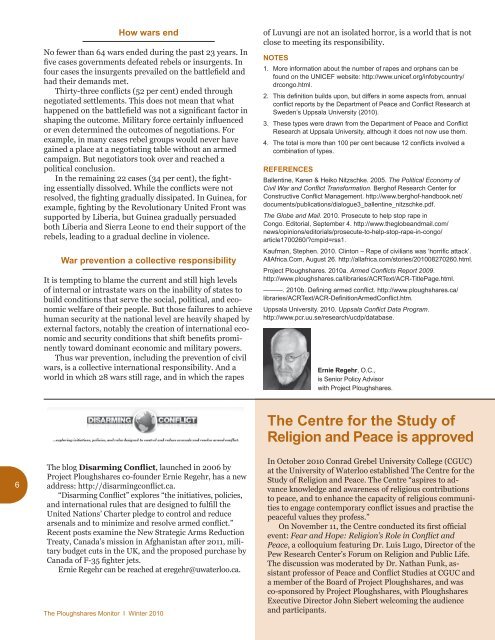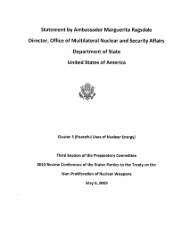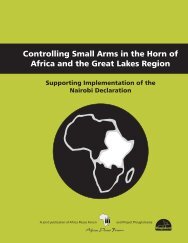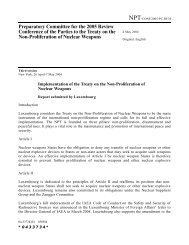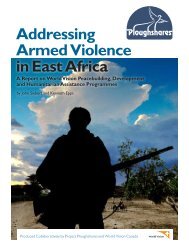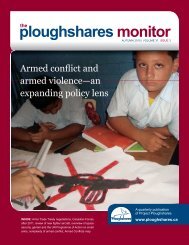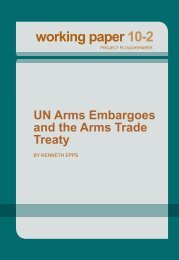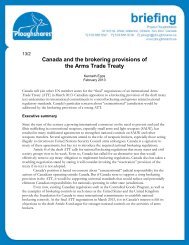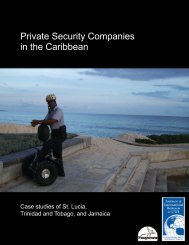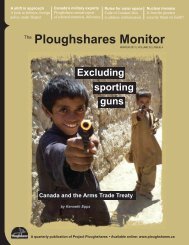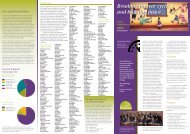Winter 2010 - Project Ploughshares
Winter 2010 - Project Ploughshares
Winter 2010 - Project Ploughshares
You also want an ePaper? Increase the reach of your titles
YUMPU automatically turns print PDFs into web optimized ePapers that Google loves.
How wars endNo fewer than 64 wars ended during the past 23 years. Infive cases governments defeated rebels or insurgents. Infour cases the insurgents prevailed on the battlefield andhad their demands met.Thirty-three conflicts (52 per cent) ended throughnegotiated settlements. This does not mean that whathappened on the battlefield was not a significant factor inshaping the outcome. Military force certainly influencedor even determined the outcomes of negotiations. Forexample, in many cases rebel groups would never havegained a place at a negotiating table without an armedcampaign. But negotiators took over and reached apolitical conclusion.In the remaining 22 cases (34 per cent), the fightingessentially dissolved. While the conflicts were notresolved, the fighting gradually dissipated. In Guinea, forexample, fighting by the Revolutionary United Front wassupported by Liberia, but Guinea gradually persuadedboth Liberia and Sierra Leone to end their support of therebels, leading to a gradual decline in violence.War prevention a collective responsibilityIt is tempting to blame the current and still high levelsof internal or intrastate wars on the inability of states tobuild conditions that serve the social, political, and economicwelfare of their people. But those failures to achievehuman security at the national level are heavily shaped byexternal factors, notably the creation of international economicand security conditions that shift benefits prominentlytoward dominant economic and military powers.Thus war prevention, including the prevention of civilwars, is a collective international responsibility. And aworld in which 28 wars still rage, and in which the rapesof Luvungi are not an isolated horror, is a world that is notclose to meeting its responsibility.Notes1. More information about the number of rapes and orphans can befound on the UNICEF website: http://www.unicef.org/infobycountry/drcongo.html.2. This definition builds upon, but differs in some aspects from, annualconflict reports by the Department of Peace and Conflict Research atSweden’s Uppsala University (<strong>2010</strong>).3. These types were drawn from the Department of Peace and ConflictResearch at Uppsala University, although it does not now use them.4. The total is more than 100 per cent because 12 conflicts involved acombination of types.ReferencesBallentine, Karen & Heiko Nitzschke. 2005. The Political Economy ofCivil War and Conflict Transformation. Berghof Research Center forConstructive Conflict Management. http://www.berghof-handbook.net/documents/publications/dialogue3_ballentine_nitzschke.pdf.The Globe and Mail. <strong>2010</strong>. Prosecute to help stop rape inCongo. Editorial, September 4. http://www.theglobeandmail.com/news/opinions/editorials/prosecute-to-help-stop-rape-in-congo/article1700260/?cmpid=rss1.Kaufman, Stephen. <strong>2010</strong>. Clinton – Rape of civilians was ‘horrific attack’.AllAfrica.Com, August 26. http://allafrica.com/stories/<strong>2010</strong>08270260.html.<strong>Project</strong> <strong>Ploughshares</strong>. <strong>2010</strong>a. Armed Conflicts Report 2009.http://www.ploughshares.ca/libraries/ACRText/ACR-TitlePage.html.———. <strong>2010</strong>b. Defining armed conflict. http://www.ploughshares.ca/libraries/ACRText/ACR-DefinitionArmedConflict.htm.Uppsala University. <strong>2010</strong>. Uppsala Conflict Data Program.http://www.pcr.uu.se/research/ucdp/database.Ernie Regehr, O.C.,is Senior Policy Advisorwith <strong>Project</strong> <strong>Ploughshares</strong>.6Check it out!The blog Disarming Conflict, launched in 2006 by<strong>Project</strong> <strong>Ploughshares</strong> co-founder Ernie Regehr, has a newaddress: http://disarmingconflict.ca.“Disarming Conflict” explores “the initiatives, policies,and international rules that are designed to fulfill theUnited Nations’ Charter pledge to control and reducearsenals and to minimize and resolve armed conflict.”Recent posts examine the New Strategic Arms ReductionTreaty, Canada’s mission in Afghanistan after 2011, militarybudget cuts in the UK, and the proposed purchase byCanada of F-35 fighter jets.Ernie Regehr can be reached at eregehr@uwaterloo.ca.The <strong>Ploughshares</strong> Monitor I <strong>Winter</strong> <strong>2010</strong>The Centre for the Study ofReligion and Peace is approvedIn October <strong>2010</strong> Conrad Grebel University College (CGUC)at the University of Waterloo established The Centre for theStudy of Religion and Peace. The Centre “aspires to advanceknowledge and awareness of religious contributionsto peace, and to enhance the capacity of religious communitiesto engage contemporary conflict issues and practise thepeaceful values they profess.”On November 11, the Centre conducted its first officialevent: Fear and Hope: Religion’s Role in Conflict andPeace, a colloquium featuring Dr. Luis Lugo, Director of thePew Research Center’s Forum on Religion and Public Life.The discussion was moderated by Dr. Nathan Funk, assistantprofessor of Peace and Conflict Studies at CGUC anda member of the Board of <strong>Project</strong> <strong>Ploughshares</strong>, and wasco-sponsored by <strong>Project</strong> <strong>Ploughshares</strong>, with <strong>Ploughshares</strong>Executive Director John Siebert welcoming the audienceand participants.


